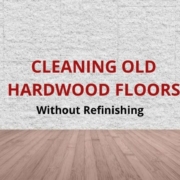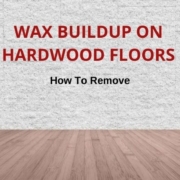How To Wax Hardwood Floors
Waxing hardwood floors refers to a procedure that involves applying solid or liquid wax to restore the sheen of your hardwood floor.
While it is no longer as commonly relied on as it once was decades ago, several homeowners are now opting for the practice due to its ability to provide their flooring with that elegant sheen that sets it apart from others with a polyurethane finish.
In this article, we examine the specific advantages of waxing your hardwood floors, when to do so and how to wax hardwood floors. We also discuss how to care for your floors once you have waxed them so their trademark gleam will be maintained for longer.
Should You Wax Your Hardwood Floors?
Yes you should, as long your floors do not have a polyurethane finish, are in excellent condition and you are using the right type of wax.
Below we have listed the benefits and drawbacks of waxing your hardwood floors.
Benefits of Waxing Hardwood Floors
- Ease of procedure: Unlike certain methods of caring for your hardwood floor, waxing is rather straightforward and can be carried out without professional help.
- Improved longevity: Waxing your floor can enhance its longevity since the product is capable of seeping into the wood and providing it with additional protection.
- Enhanced resistance to dirt: The wax applied will harden into a shiny veneer which will cover the floor in a protective layer. This coating can prevent spills from seeping into the wood and also protect it from minor scratches and scuff marks.
- Safety: Compared to polyurethane floors, most waxes have a low VOC content meaning they are a safer option.
Disadvantages of Waxing Hardwood Floors
- Substantial effort required: Although waxing is a straightforward process, it also requires a great deal of effort. Liquid waxes, for example, require repeated applications during a single floor waxing session and even solid paste waxes may require more than one coating depending on the type of your hardwood floor.
- May cause staining: It is worth noting that hardwood floor wax may bring about a change in the color of your flooring, altering its original tones as it seeps into the wood.
- Lower durability levels: Compared to polyurethane, hardwood floor wax is less durable and it is for this reason that the former is more widely preferred.
- Difficulty of removal: In spite of the relative ease of applying it, the varnish left behind is rather difficult to remove. You can read our article on how to remove wax buildup from hardwood floors which discusses the procedure in detail.
How Often Should You Wax Your Hardwood Floors?
Hardwood floors should be waxed every 12 to 18 months.
However, the ultimate determining factor of the frequency with which you will have to carry out the procedure is the amount of traffic received by a particular room or area.
Experts recommend that you do not wax your hardwood floors more than twice a year and that you ensure you wax your wood floors at least every three years.
What Is The Best Wax to Use on Hardwood Floors?
Solid Paste Wax
Products in this category are known to have a heavier consistency compared to their liquid counterparts. This is due to the fact that they come with a higher proportion of wax compared to the latter.
SC Johnson Paste Wax is an excellent example of a product in this category. The manufacturer recommends cleaning your floor with a solvent-based product before applying it with a soft cloth for optimal results.
Liquid Wax or Oil
These products are generally lighter compared to solid paste wax products — liquid wax has a higher solvent concentration (and a lower wax content) compared to paste wax.
Unlike solid paste wax products they may require several applications although a mop may be used when waxing hardwood floors with them making their application somewhat more convenient compared to that of their solid counterparts.
An example of a product in this category is the Dura Finish Liquid Wax which only requires occasional buffing and is capable of restoring the luster of your floor. It is also capable of covering 2,000 square feet per gallon and can be applied with lambswool, cloth, or fine steel wool.
Water-based Silicone
Environmentally friendly and toxin-free, water-based silicone products are ideal for hardwood floors that have a polyurethane finish.
An example is the Quick Shine Multi-Surface Finish Polish which is free from parabens and fragrance and is safe for children and pets. This water-based polish is also capable of filling out minor scratches and of giving your floor a uniform appearance.
It is also suitable for plank, laminate, and tile surfaces.
How to Wax Hardwood Floors
Things You’ll Need
- A soft-bristled brush
- A microfiber cloth or mop
- A sponge mop (if using liquid wax)
- A terry cloth (also for liquid wax)
- Mineral spirits
- A towel (if using hard wax)
- A solvent-based cleaner
- A solvent-based wax product
- A soft cloth or a mop
- A pair of gloves
- A dust mask
Preparing The Surface
- Empty room of furniture and ensure it is well ventilated.
- Check the floor for any signs of warping since waxing is unsuitable for floors in this state.
- Carefully sweep the floor to remove every trace of dust and debris.
- Wipe the floor with a cloth dampened by mineral spirits to get rid of any lingering wax residues on it.
- Mop with a solvent-based cleaner to ensure the surface is completely clean.
- Leave the room in order for the floor to dry and do not permit any entry to it as doing so may result in sand, grit, or dust being reintroduced to it.
Applying Wax to the Hardwood Floor
- Before you start to apply the wax to your wooden floors, you will need to wear your mask which will prevent you from inhaling the wax’s fumes. You will also have to wear a pair of robust rubber gloves to protect your skin.
- Next, measure out a single spoonful of liquid or solid wax and pouring it on the floor, use your mop (if you are using liquid wax) or cloth (if you are using solid paste wax) to coat the floor with it following the grain.
- Repeat the procedure, working your way from the innermost part of the room to its entrance.
- If you are using a mop, you may need to use a cloth when waxing the part of the floor close to the wall or in corners.
- Once you have finished, you may need to wait for the floor to dry before repeating the procedure, if necessary. The waiting period may range from anywhere between 10 minutes to 1 hour, depending on the type of your hardwood floor and the wax you are using.
How Many Coats of Wax Should You Put on a Hardwood Floor?
If you happen to be waxing unfinished hardwood floors with solid paste wax, you will need to coat it twice.
However if you happen to be using the same product for finished surfaces, only one coating will be required.
If you are using liquid wax, two or three coatings at the very least would be required regardless of whether you happen to be working on finished or unfinished floors.
Buffing
This final step involves passing a cloth or a mop over the floor once you have covered it with the required number of coatings.
Buffing a waxed surface is important since it will ensure the wax goes further into the hardwood and is able to protect it more effectively as a result.
How will you know when to proceed to this step? By the wax coating taking on a blurry appearance.
If you have used solid paste wax, a towel would be suitable for buffing the surface.
In the case of liquid wax, you will need to use a terry cloth.
It is also possible for you to rent a buffing machine as well. You will need to ensure you follow the directions provided carefully during the procedure.
Caring For and Maintaining Waxed Hardwood Floors
- Clean spills immediately: Any fluids which spill must be cleaned instantly and thoroughly with an absorbent dry cloth. Doing so will prevent them from marring the wax finish and from possibly staining your floor.
- Check wax coating at intervals: Carry out periodic checks of the coating to determine if a fresh coat of wax is required. You will be able to do so by slightly wetting a soft cloth and wiping it on the surface. The presence of a whitish residue means that no waxing is required. However if the cloth comes away with none, it will mean that the wax coating has worn off and more must be applied.
- Buff any imperfections: If you notice any uneven spots on the hardwood surface, you will need to buff it with a thick towel. Doing so will enable you to restore a uniform luster to your floor.
- Protect surface with rugs and mats: The waxed hardwood floor should be protected from dirt, possible scratching from grit, and from wear by placing rugs, mats, and runners at high traffic areas and room entrances.
* Last updated on 2024-07-27 / We are using affiliate links / All images are served from the Amazon Product Advertising API.
Table of Contents







